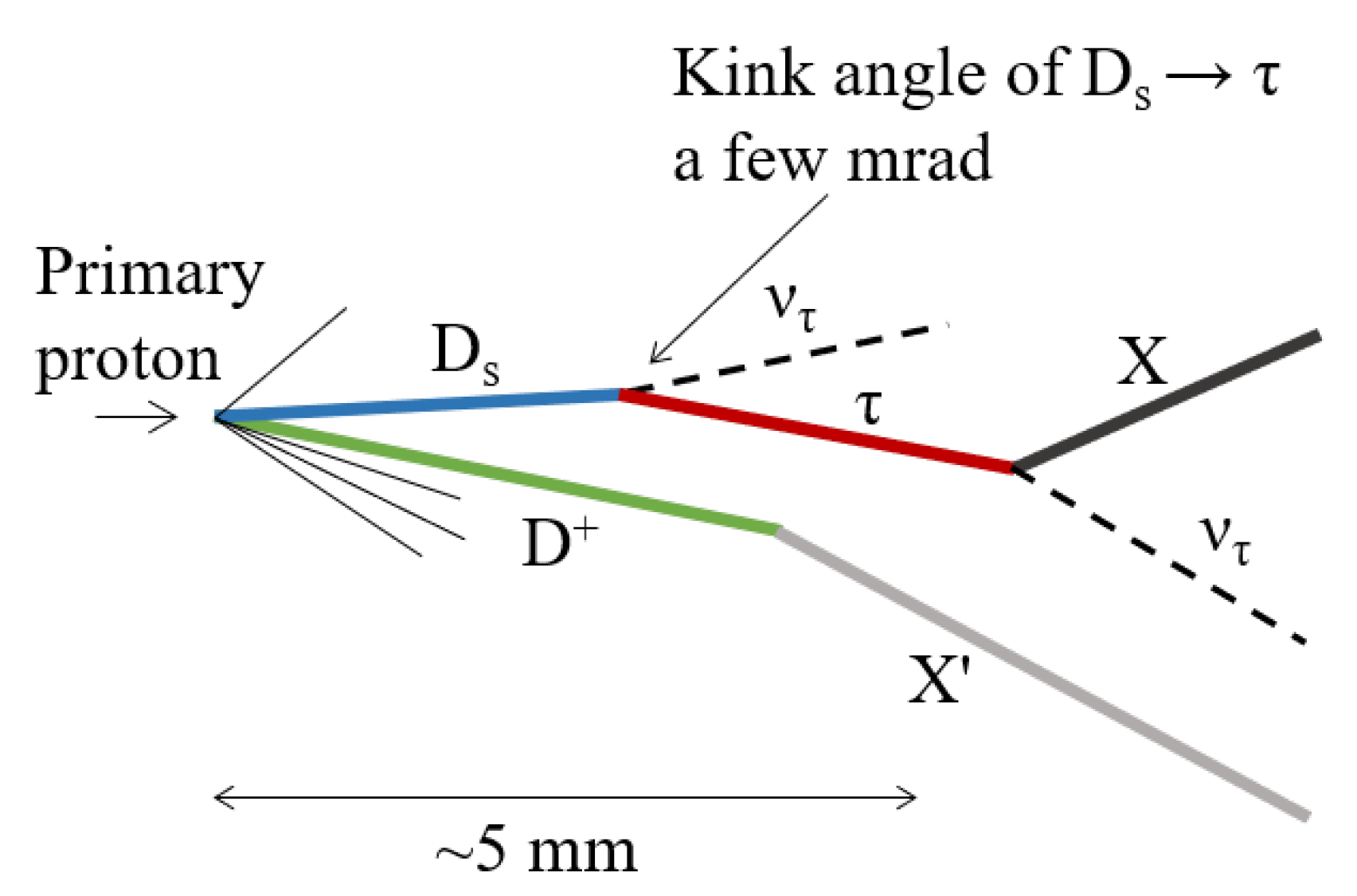The DsTau Experiment: A Study for Tau-Neutrino Production
Abstract
1. Introduction
2. Materials and Methods
3. Results
4. Conclusions and Outlook
Funding
Acknowledgments
Conflicts of Interest
References
- Perl, M.L.; Abrams, G.S.; Boyarski, A.M.; Breidenbach, M.; Briggs, D.D.; Bulos, F.; Chinowsky, W.; Dakin, J.T.; Feldman, G.J.; Friedberg, C.E.; et al. Evidence for Anomalous Lepton Production in e+- e− Annihilation. Phys. Rev. Lett. 1975, 35, 1489. [Google Scholar] [CrossRef]
- DONUT Collaboration; Kodama, K.; Ushida, N.; Andreopoulos, C.; Saoulidou, N.; Tzanakos, G.; Yager, P.; Baller, B.; Boehnlein, D.; Freeman, W.; et al. Observation of tau neutrino interactions. Phys. Lett. B 2001, 504, 218–224. [Google Scholar] [CrossRef]
- DONuT Collaboration; Kodama, K.; Ushida, N.; Andreopoulos, C.; Saoulidou, N.; Tzanakos, G.; Yager, P.; Baller, B.; Boehnlein, D.; Freeman, W.; et al. Final tau-neutrino results from DONuT experiment. Phys. Rev. D 2008, 78, 052002. [Google Scholar] [CrossRef]
- Anelli, M.; Aoki, S.; Arduni, G. A facility to Search for Hidden Particles (SHiP) at the CERN SPS, CERN-SPSC-2015-016, SPSC-P-350. arXiv 2015, arXiv:1504.04956. [Google Scholar]
- DsTau Collaboration; Aoki, S.; Ariga, A.; Ariga, T.; Dmitrievsky, S.; Firu, E.; Forshaw, D.; Fukuda, T.; Gornushkin, Y.; Guler, A.M.; et al. DsTau: Study of tau neutrino production with 400 GeV protons from the CERN-SPS. J. High Energy Phys. 2020, 2020, 1–26. [Google Scholar]
- Aoki, S.; Ariga, A.; Ariga, T.; Firu, E.; Fukuda, T.; Gornushkin, Y.; Guler, A.M.; Haiduc, M.; Kodama, K.; Korkmaz, M.A.; et al. Experiment Proposal, Study of tau-neutrino production at the CERN SPS, CERN-SPSC-2017-029, SPSC-P-354. arXiv 2017, arXiv:1708.08700. [Google Scholar]





© 2020 by the authors. Licensee MDPI, Basel, Switzerland. This article is an open access article distributed under the terms and conditions of the Creative Commons Attribution (CC BY) license (http://creativecommons.org/licenses/by/4.0/).
Share and Cite
Miloi, M.M.; [DsTau Collaboration]. The DsTau Experiment: A Study for Tau-Neutrino Production. Particles 2020, 3, 164-168. https://doi.org/10.3390/particles3010013
Miloi MM, [DsTau Collaboration]. The DsTau Experiment: A Study for Tau-Neutrino Production. Particles. 2020; 3(1):164-168. https://doi.org/10.3390/particles3010013
Chicago/Turabian StyleMiloi, Mădălina Mihaela, and [DsTau Collaboration]. 2020. "The DsTau Experiment: A Study for Tau-Neutrino Production" Particles 3, no. 1: 164-168. https://doi.org/10.3390/particles3010013
APA StyleMiloi, M. M., & [DsTau Collaboration]. (2020). The DsTau Experiment: A Study for Tau-Neutrino Production. Particles, 3(1), 164-168. https://doi.org/10.3390/particles3010013




